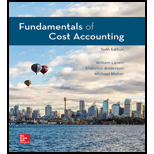
Fundamentals of Cost Accounting
6th Edition
ISBN: 9781260708783
Author: LANEN, William
Publisher: MCGRAW-HILL HIGHER EDUCATION
expand_more
expand_more
format_list_bulleted
Concept explainers
Question
Chapter 10, Problem 55E
To determine
Classify the given costs according to the information given in the question.
Expert Solution & Answer
Want to see the full answer?
Check out a sample textbook solution
Students have asked these similar questions
General accounting question
What was the amount of credit sales during August
What is the target stock price in one year
Chapter 10 Solutions
Fundamentals of Cost Accounting
Ch. 10 - How are activity-based costing and activity-based...Ch. 10 - Can activity-based management be implemented...Ch. 10 - Prob. 3RQCh. 10 - What are some ways in which customers affect a...Ch. 10 - How is computing the cost of customers the same as...Ch. 10 - Prob. 6RQCh. 10 - Prob. 7RQCh. 10 - Under what conditions should the cost of excess...Ch. 10 - In what ways does quality affect cost?Ch. 10 - What are the four categories in a cost of quality...
Ch. 10 - Prob. 11CADQCh. 10 - Prob. 12CADQCh. 10 - Consider a library that spends 25,000 to move most...Ch. 10 - Prob. 14CADQCh. 10 - Prob. 15CADQCh. 10 - You can get the cost of customers by first...Ch. 10 - Prob. 17CADQCh. 10 - Prob. 18CADQCh. 10 - Prob. 19CADQCh. 10 - Prob. 20CADQCh. 10 - Many if not most schools in the United States have...Ch. 10 - Prob. 22CADQCh. 10 - Prob. 23CADQCh. 10 - Prob. 25ECh. 10 - Prob. 26ECh. 10 - Prob. 27ECh. 10 - Cost Hierarchy for a Not-for-Profit Below are...Ch. 10 - Prob. 29ECh. 10 - Driver Identification Below are various activities...Ch. 10 - Activity-Based Costing of Customers Marvins...Ch. 10 - Activity-Based Costing of Customers Rock Solid...Ch. 10 - Prob. 33ECh. 10 - Prob. 34ECh. 10 - Prob. 35ECh. 10 - Activity-Based Costing of Suppliers Hult Games...Ch. 10 - Prob. 37ECh. 10 - Activity-Based Costing of Suppliers Kinnear...Ch. 10 - Prob. 39ECh. 10 - Resources Used versus Resources Supplied Tri-State...Ch. 10 - Prob. 41ECh. 10 - Resources Used versus Resources Supplied Conlon...Ch. 10 - Prob. 43ECh. 10 - Prob. 44ECh. 10 - Prob. 45ECh. 10 - Prob. 46ECh. 10 - Assigning Cost of Capacity Mimis Fixtures...Ch. 10 - Assigning Cost of Capacity Curts Casting...Ch. 10 - Prob. 49ECh. 10 - Costs of Quality The following represents the...Ch. 10 - Prob. 51ECh. 10 - Costs of Quality Nuke-It-Now manufactures...Ch. 10 - Prob. 53ECh. 10 - Cost of Quality: Environmental Issues Many...Ch. 10 - Prob. 55ECh. 10 - Prob. 56PCh. 10 - Activity-Based Reporting: Service Organization...Ch. 10 - Prob. 58PCh. 10 - Customer Profitability Carmel Company has a...Ch. 10 - Activity-Based Costing of Suppliers JFI Foods...Ch. 10 - Prob. 61PCh. 10 - Prob. 62PCh. 10 - Prob. 63PCh. 10 - Activity-Based Reporting: Manufacturing...Ch. 10 - Assigning Capacity Costs Cathy and Toms Specialty...Ch. 10 - Prob. 66PCh. 10 - Prob. 67PCh. 10 - Assigning Capacity Costs Mercia Chocolates...Ch. 10 - Prob. 69PCh. 10 - Prob. 70PCh. 10 - Prob. 71P
Knowledge Booster
Learn more about
Need a deep-dive on the concept behind this application? Look no further. Learn more about this topic, accounting and related others by exploring similar questions and additional content below.Similar questions
- Give me correct answerarrow_forwardHi expert please give me answer general accounting questionarrow_forwardPluto Flyers, Inc., has balance sheet equity of $6.2 million. At the same time, the income statement shows net income of $865,000. The company company paid dividends of $472,500 and has 120,000 shares of stock outstanding. If the benchmark PE ratio is 20, what is the target stock price in one year? Answer: $144.20arrow_forward
arrow_back_ios
SEE MORE QUESTIONS
arrow_forward_ios
Recommended textbooks for you
- Principles of Accounting Volume 2AccountingISBN:9781947172609Author:OpenStaxPublisher:OpenStax College
 Cornerstones of Cost Management (Cornerstones Ser...AccountingISBN:9781305970663Author:Don R. Hansen, Maryanne M. MowenPublisher:Cengage Learning
Cornerstones of Cost Management (Cornerstones Ser...AccountingISBN:9781305970663Author:Don R. Hansen, Maryanne M. MowenPublisher:Cengage Learning Auditing: A Risk Based-Approach (MindTap Course L...AccountingISBN:9781337619455Author:Karla M Johnstone, Audrey A. Gramling, Larry E. RittenbergPublisher:Cengage Learning
Auditing: A Risk Based-Approach (MindTap Course L...AccountingISBN:9781337619455Author:Karla M Johnstone, Audrey A. Gramling, Larry E. RittenbergPublisher:Cengage Learning  Managerial AccountingAccountingISBN:9781337912020Author:Carl Warren, Ph.d. Cma William B. TaylerPublisher:South-Western College Pub
Managerial AccountingAccountingISBN:9781337912020Author:Carl Warren, Ph.d. Cma William B. TaylerPublisher:South-Western College Pub Financial And Managerial AccountingAccountingISBN:9781337902663Author:WARREN, Carl S.Publisher:Cengage Learning,
Financial And Managerial AccountingAccountingISBN:9781337902663Author:WARREN, Carl S.Publisher:Cengage Learning, Auditing: A Risk Based-Approach to Conducting a Q...AccountingISBN:9781305080577Author:Karla M Johnstone, Audrey A. Gramling, Larry E. RittenbergPublisher:South-Western College Pub
Auditing: A Risk Based-Approach to Conducting a Q...AccountingISBN:9781305080577Author:Karla M Johnstone, Audrey A. Gramling, Larry E. RittenbergPublisher:South-Western College Pub

Principles of Accounting Volume 2
Accounting
ISBN:9781947172609
Author:OpenStax
Publisher:OpenStax College

Cornerstones of Cost Management (Cornerstones Ser...
Accounting
ISBN:9781305970663
Author:Don R. Hansen, Maryanne M. Mowen
Publisher:Cengage Learning

Auditing: A Risk Based-Approach (MindTap Course L...
Accounting
ISBN:9781337619455
Author:Karla M Johnstone, Audrey A. Gramling, Larry E. Rittenberg
Publisher:Cengage Learning

Managerial Accounting
Accounting
ISBN:9781337912020
Author:Carl Warren, Ph.d. Cma William B. Tayler
Publisher:South-Western College Pub

Financial And Managerial Accounting
Accounting
ISBN:9781337902663
Author:WARREN, Carl S.
Publisher:Cengage Learning,

Auditing: A Risk Based-Approach to Conducting a Q...
Accounting
ISBN:9781305080577
Author:Karla M Johnstone, Audrey A. Gramling, Larry E. Rittenberg
Publisher:South-Western College Pub
What is variance analysis?; Author: Corporate finance institute;https://www.youtube.com/watch?v=SMTa1lZu7Qw;License: Standard YouTube License, CC-BY